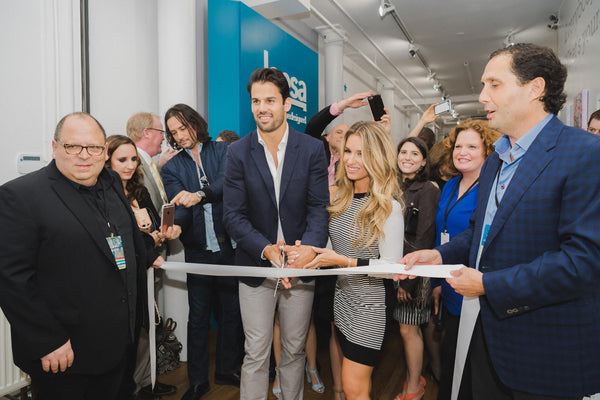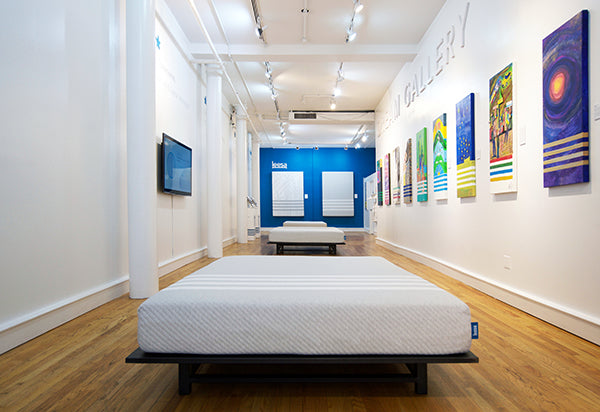What do you dream about? I dream of a world where endless possibilities are realized. —Artist Kitty Zen
Humans spend about one-third of their lives sleeping. And some of us likely spend the other two-thirds of our waking hours dreaming about going back to bed.
That’s partially why two entrepreneurs decided to take on the stagnant $14 billion mattress industry. Business partners David Wolfe and Jaime Diamonstein put their heads together back in 2014 to start Leesa, a high-end online mattress retailer, to disrupt the mostly unchanged sleep industry.
In the founders’ minds, if we spend so much time sleeping, it only makes sense to sleep well. That’s why Virginia-based Leesa is a consumer-facing luxury mattress retailer that delivers American-made products directly to consumer’s doors — getting a good night's rest should be as easy as a few mouse clicks.
Since then, Leesa has experienced exponential growth and racked up several accolades. In their second month of business, the merchant managed to pull in an impressive $1 million. Not too shabby for an organization that prides itself on making most of its first sales through word-of-mouth referrals.
In 2015, Leesa picked up even more momentum with a win at the Shopify’s Build A Business competition. The merchant was also awarded the title of “fastest growing e-retailer” in the Internet Retailers 2016 Top 500 Guide.
From Clicks to Bricks: The Leesa Dream Gallery

Photo credit: Susan Shek
After seeing such success in just a little over a year of business, Leesa made its first foray into the world of physical retail with a unique storefront concept: an immersive retail experience aptly titled the “Leesa Dream Gallery.”
The team realized that Leesa needed to create opportunities to establish long-lasting customer relationships in order to stand out and grab more market share. Purchasing a mattress is an investment — with Leesa mattresses retailing for around $900, many shoppers understandably want to touch and try out the product before handing over that much cash.
As a result, they're connecting in person with their customers via their new Dream Gallery retail experience. So, while online sales remain robust, a physical showroom allows shoppers to interact with the product firsthand, take off their shoes, and lie down for a while to experience the multiple layers of the Leesa mattress.
“Our goal was and remains for the space to be part ‘billboard,’ and partially a place to experience our mattress in a relaxing, different kind of space,” said cofounder David Wolfe regarding the motivation behind the Dream Gallery. “We always wanted to be the first to present mattress designs as art. Hence the [idea behind the] gallery.”
On April 27, 2016, the Leesa team, investors, and a crowd of guests cut the blue ribbon on the first Leesa Dream Gallery on Wooster Street in New York City. The immersive retail exhibit offers Leesa fans and prospective customers an environment to touch and feel the product and get a firsthand understanding of the value proposition, i.e. a high-quality mattress that facilitates equally high-quality sleep.
During the opening, the space was filled with A-list supporters such as NFL wide receiver Dale Moss, Grammy winner Bridget Kelly, actor Constantine Maroulis, and a special group of formerly homeless artists. In addition to hosting a display of Leesa’s mattresses for attendees to try out, the gallery space also boasted paintings and works from a bevy of homeless artists, underscoring Leesa’s dedication to impacting the lives of those who are less fortunate.
At the opening, there was a palpable inspiring energy in the crowd throughout the night as guests were invited to experience the dreams that the gallery opening enabled — both their own through a good night’s rest and the artists the gallery supports.
Social Impact: An Experiential Exhibit
Since Leesa’s inception, the merchant has measured its success not just by its growing bottom line, but also by the company’s overall social impact. Their mission is to bring everyone a better way to sleep and a pathway to a better life through better rest.
While that lofty mandate may sound as dreamy as their mattresses, Leesa has already made some solid progress with their multi-prong approach. This was evident during their Leesa Dream Gallery launch, where they partnered with ArtLifting, an online marketplace for homeless, disabled and other disadvantaged artists to sell their artwork.
“This opening is completely life changing. Our goal is treating artists with the respect they deserve and this gallery is the highest level you could imagine,” said Liz Powers, cofounder of ArtLifting.
“It’s important to uplift people — you impact their lives in a powerful way,” noted Leesa investor Eric Decker.
As part of ArtLifting, artists create their work in shelter and disability center programs and earn 55% of the royalties from each sale. During the gallery's opening night alone, about one-third of the pieces were sold to a crowd of happy buyers.
“I walked in and saw my art and then I was told I already sold a piece, I was shocked,” noted Ruben Lopez, one of the artists whose work was displayed during the Dream Gallery opening.
One-for-Ten, One-Earth
This isn’t Leesa’s first initiative helping homeless residents. Making an impact on the lives of the displaced and disadvantaged is core to Leesa’s mission. Unofficial reports estimate that anywhere from 1.9 million to 3.5 million Americans are homeless, and Leesa’s founders are dedicated to giving as many as possible a better place to sleep. In addition to working with ArtLifting on the Dream Gallery, the merchant sponsors a One-Ten program, where Leesa donates one mattress to a homeless shelter for every 10 they sell. To date, Leesa has donated more than 5,000 mattresses to help those who would otherwise not have a place to sleep.
Sustainable retail is also at the core of Leesa’s operations. They’ve partnered with the Arbor Day Foundation to plant one million trees by 2025. In 2015, they planted 32,000 trees in the CO Pike National Forest, and in 2016 they plan to plant another 50,000.
Lessons From Leesa’s Experiential Retail Exhibit

Photo credit: Susan Shek
While Leesa isn’t ready to reveal its future plans for the Dream Gallery (or more locations like it), cofounder David Wolfe did readily offered a few hard-learned lessons on how the team created an “experiential channel” with their retail storefront.
Tip 1: Know Your Goal and Tell a Compelling Story
What was the goal of your pop-up retail store? Why is it called a Dream Gallery versus naming it something else?
David: Our goal has two elements to it: A mobile experiential space and a fixed experiential space. This is obviously the fixed one. Our plan is to continue as long as it makes sense. Nothing we did in the gallery feels temporary — that’s because it’s not intended to be. It’s a place where you can immerse yourself in our brand.
When we realized it also gave us the chance to showcase the art of homeless, formerly homeless and disabled artists, the name “gallery” made even more sense.
Tip 2: Design In-Store Points of Engagement
At the Leesa Dream Gallery, there are a number of opportunities for a customer to engage with the brand: the dream wall, the art gallery, the mattresses. How did you conceptualize each area?
David: Our background is in bringing new ideas to life. Retail experiences need to be totally immersive for them to be effective. So when you walk into the dream store, you're surrounded by opportunities to interact with our brand. The mattress is obvious, but we also have videos playing, customer reviews on the walls, interactive kiosks, blankets, coffee, and, of course, the artwork.
Tip 3: Assemble an In-Store Team to Convey Your Company Culture
What are three things a founding team can do to ensure their in-store pop-up team truly represents an extension of their brand?
David: Selection, training, and on-going motivation.
Tip Four: Constantly Collect and Analyze Data
What is your advice on collecting useful data in a pop-up retail environment?
David: There are so many ways to measure the success of a retail store. We try to look at granular data, the big picture, and anecdotal evidence. We have developed ways to do all three. Then it’s about your gut feel. I often say “this feels good,” let’s continue — sometimes even when there is evidence to the contrary. Sometimes there is no substitute for intuition and drive.
The Bottom Line
While pop-up stores are innately short term in nature, the impression that a brand leaves on its customers is permanent. The team at Leesa invested in approaching their retail experience with that thought process in mind. In order to effectively achieve that, a brand must take the time to start with a clear vision of its goals and the story it wants to tell through their space.
For the Leesa team, they're empowering better sleep and unlimited dreams. That’s a powerful message to pass on to their customers.
 About The Author
About The Author
Read more
- How One Disruptive Menswear Brand Transformed a Pop-up Space in SoHo, NY
- How This Lingerie Brand Hustled to Become a B2B Force in the Athleisure Industry
- Selling Anywhere: How These Retailers Built a Community With Multichannel Sales
- How PDPAOLA Improved Customer Lifetime Value by Unifying its Customer Data
- How Ryzon Increased Store Conversion Rates by Over 40% with Shopify POS
- How Florentine Kitchen Knives Sped Up Store Checkout by 50% with Shopify
- MAAP Rides to Customer Success with Shopify POS
- The Sheet Society Dreamed of Increasing Their Sales and Shopify was the Perfect Fit
- How Il Conte Improved its Inventory Management with Shopify POS





